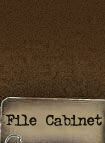|
This investigation was initiated
after close analysis of numerous
photographs and film footage of the
shooting incident on Dam Square in
Amsterdam, two days after the
Germans had surrendered. Close study
of the available images revealed
that there hardly exist any pictures
of the soldiers who started shooting
rifles and machine guns into a crowd
that had gathered on Dam Square.
This Battle Study sheds light on
details of the actual shooting and
what had started it.
SYNOPSIS:
It is estimated that about fifteen
photographers and movie camera
operators were present when a crowd
started getting bigger and bigger on
the 7th of May 1945. Two days
earlier, German Generaloberst
Johannes Blaskowitz
signed a treaty
in Wageningen, stating that all
German forces in The Netherlands
surrendered. Even on the 7th of
May,
the people of Amsterdam had not seen
any of its Allied liberators. Armed
German soldiers were still on the
streets but on the 7th news had it
that Canadian forces would enter the
city. To welcome them, crowds grew,
a
special pedestal was installed in
front of the Royal Palace on Dam
Square, an organ played music and
armed and uniformed members of
the Netherlands Internal Armed
Forces (Binnenlandse Strijdkrachten
or "BS" in Dutch)
patrolled the
streets. Finally some reconnaissance
vehicles appear. The odd situation
developed that German trucks, laden
with armed soldiers and British
armored cars drove past each other
with numerous citizens in between
them:
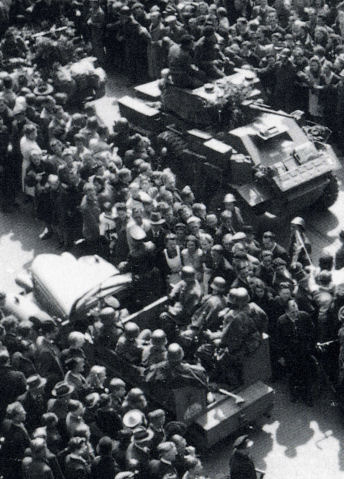
Meanwhile armed member of the BS
start disarming stray German
soldiers. Then, at about three
o'clock a single shot sounds form
the direction of the Royal Palace,
followed by automatic gun fire.
Panic breaks out.
The triggering cause
It is often said that the
disarmament of a German soldier by
member of the BS resistance group on
the corner of Spui Straat and Paleis
Straat, led to the shooting
incident.
The situation shortly before this
alleged incident, was photographed:
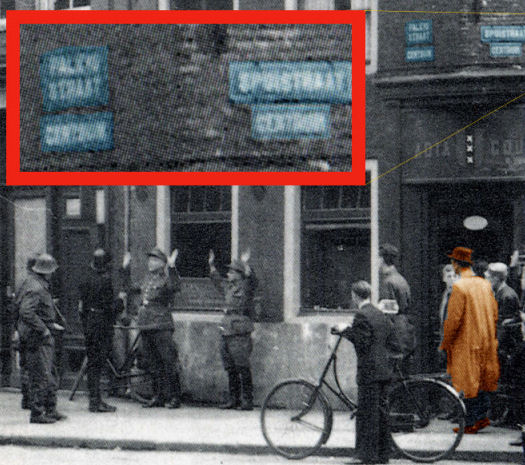
For two reasons, however, it
is doubtful if this is really what
caused the shooting.
Kriegsmarine men want to end
vigilante tribunal, 'trying' Dutch
women
In the official documentation of Dr.
Lou de Jong's The Kingdom of the
Netherlands in World War Two, Part
10b,
second volume we read about the
start of the shooting:
"What was the cause? It is not
determined (there has been no
official investigation). In that
period itself it was
believed that
men of the Kriegsmarine, who had
barricaded themselves inside in the
building of the Grote Club
(Grand
Club), which was situated near the
entrance of Kalver Straat, wanted to
come to the aid of a German soldier
who , under the Kriegsmarine's eyes,
had come into a gun fight with a
BS-member who wanted to disarm him-
an eyewitness named P.K. Marquenie
who was twenty four at the time
wrote us however in '68 that the
shooting had
had a different start.
On Dam Square, close to the balcony
of the Grote Club, was, according to
his recollection,
a truck
'and on this
hand-pushed truck women who had had
relations with Germans were brought
in,
under the crowd's hilarity. These
women were tried before some kind of
tribunal. The heads were shaven and
painted with lead vermillion. All
this did not happen quite gently.
Blood poured over their faces. The
women screamed and cried for help.
This all happened under the eyes of
the Germans.
The Germans shouted to leave
the women alone, this, however did
not happen. Meanwhile BS-ers circled
the Palace. Some of them stood at
the organ with loaded rifles or
something like that.
The commotion and the screaming
of the women grew heavier. Then
shots were fired. At first the
Germans fired over
the heads. The
BS-ers took cover behind the organ
and shot at the balcony, diagonally
above their heads.'-
before long the Germans and
the BS-ers started shooting at each
other, and the Germans' intent went
so far that
they started firing one
or more machine guns. Among them
there were no casualties, as far as
is known, nor among
the BS-ers, but yet among the common
citizens on Dam, who in deadly fear
took cover on the square or ran away
(many on bare feet to run faster) there were
many: there were twenty two dead and
almost sixty severely wounded
of
whom some (their number is unknown)
later passed away."
Kriegsmarine men could not see
the disarmament scene on Paleis
Straat
Unless the Kriegsmarine men leaned
out of the windows of the Groote
Club, they could not see what was
going on at the corner of Spui
Straat and Paleis Straat.
Photographic evidence shows that prior to the
shooting, personnel of the German Kriegsmarine was seen on the rooftop
and behind the windows of the
balcony of the Groote Club.
Rooftop
This photograph shows nine Germans
on the rooftop and was taken before
the shooting started:
(click on the
thumbnail to enlarge)

We have enlarged the soldiers in the
previous photograph. This picture
shows that all of them lean against,
or sit on
top of, a guard rail on the
rooftop. This photograph was taken
by Wiel van der Randen and is
copyrighted by the
Spaarnestad Photo Archive of
Haarlem, The Netherlands.
(click on the image
for an enlargement)

UPDATE 6MAR2016: Images of
disarmaments on Dam Square in view
of Kriegsmarine men
We have recently discovered two
photos taken on Dam on may 7 1945 of
of Dutch Forces of the Interior (BS
in Dutch) disarming German military.
One image, in full color, shows two
men in civilian cloths with their
hands up, herded forward by a Sten
gun toting Dutch BS-man.
(click on the image
for an enlargement)

The other image is in black and
white and shows a BS-man disarming a
man in a uniform we have not
identified yet:
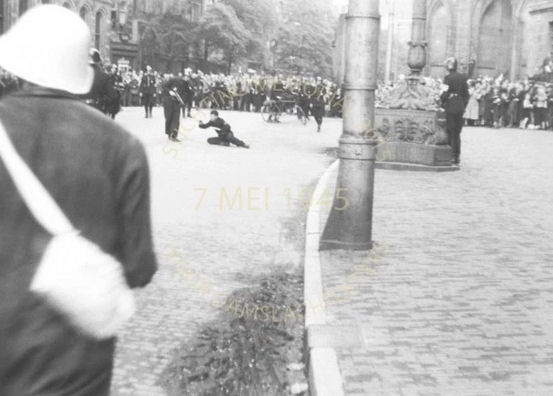
We have enlarged the image to show
that, judging from the ornate lamp
posts, the scene took place close to
the Royal Palace on Dam:
(click on the image
for an enlargement)
.jpg)
These scenes are likely to have
irritated the Kriegsmarine men in De
Groote Club, causing them to
intervene by opening fire on the
BS-men and the crowd.
Balcony
Various photographs show the balcony
and the window behind it.
In this photograph, taken earlier
when the crowd on Dam starts to
swell, we see that the doors and the
curtains
behind the balcony are
closed:
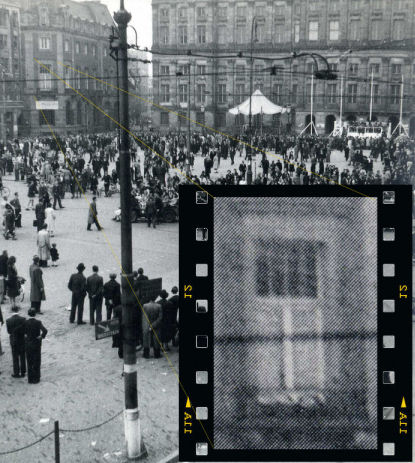
A short while later, when the crowd
got bigger, the curtains were moved
and figures, looking through windows
in the doors behind the balcony are
visible. The barbed-wire road blocks
in front of the entrance under the
balcony can be seen.

The next photograph was taken
during, or shortly after, the
shooting. The doors, leading to the
balcony, are opened.
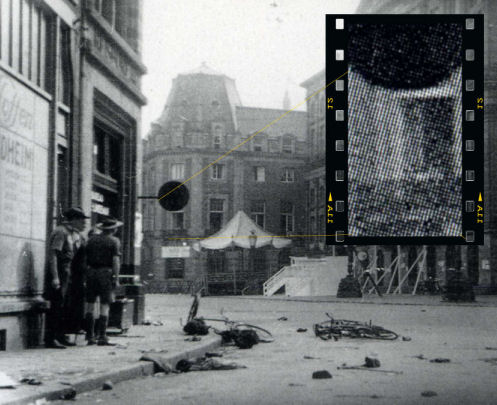
|


